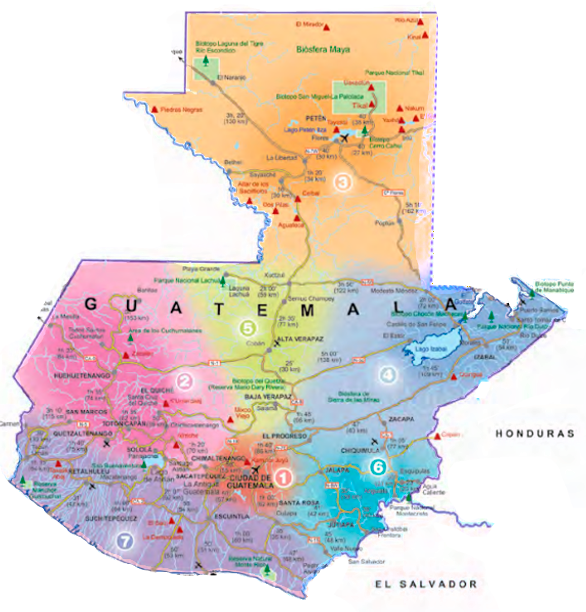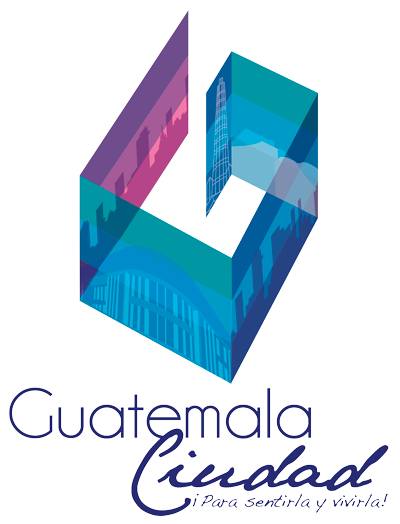Regions of Guatemala
Guatemala is recognized worldwide for its cultural richness, with twenty-two ethnic groups of Mayan origin, the Garinagu people better known as Garífuna, as well as Xinca and mestizos, who share their traditions and customs, religious mysticism, the Mayan worldview, gastronomy, crafts, living culture of a thousand-year-old people with pre-Hispanic and Hispanic ancestral heritage, archaeological wealth and 169 monumental sites, dating back more than 3,500 years of history, characteristics that make the country, the Heart of the Mayan World.
This historical, natural and cultural heritage of Guatemala can be discovered throughout its time. The magic and mystery of the Mayan World subsist in ancient cities. The faces and kindness of the people, as well as the color of the regional costumes, are the echo of an impressive colonial past, which can still be heard in churches and convents. It is the contact with an exuberant nature, origin and destination of a unique biodiversity in the world.
Guatemala is the ideal destination to appreciate nature, it has extensive beaches of volcanic origin in the Pacific, as well as white sand in the Caribbean. The country is crossed by a volcanic and mountainous chain that offers spectacular landscapes from impressive rock formations, active volcanoes, cloud forests, beautiful lakes and mighty rivers. Likewise, it has approximately 33% of its territory integrated within a system of protected areas, which guarantees the protection of its beautiful landscapes, abundant natural resources and rich biodiversity.
Due to its ecological diversity and cultural variety of the country, it has been divided into 7 tourist regions that have their own identity and an impressive variety of tourist attractions that make it unique:

GUATEMALA, Modern and Colonial
The departments of Guatemala and Sacatepéquez are located in this region.
Guatemala City is the entry point for all visitors who enter by air, it is the most modern and cosmopolitan in the Central American region. Due to its harmonious development, it was conferred the title of Ibero-American Capital of Culture in 2015, with its Historic Center, business centers, shopping centers, convention centers, central market and handicrafts market; it also has golf courses and private medical services with high standards. Guatemala City is ideal for holding weddings, events and special meetings with top quality facilities and technology.
In Sacatepéquez is located La Antigua Guatemala, the main icon of the colonial Hispanic heritage, it is located in the Panchoy Valley, surrounded by three volcanoes and mountains with coffee plantations, macadamia, flowers, among others. It was declared Cultural Heritage of Humanity by UNESCO in 1979. It offers a very rich sample of architecture, monuments, colonial, churches, imagery and altarpieces from the colonial era, you can also visit markets, artisan workshops, study centers and schools of Spanish. It is a setting in which cultural and religious traditions come to life, ideal for holding weddings, events and special meetings with top-quality facilities and technology.

HIGHLANDS, Living Maya Culture
The departments of Huehuetenango, Quiché, Chimaltenango, Totonicapán, Sololá and the northern part of San Marcos are located in this region.
In this territory of pre-Hispanic and colonial history the visitor appreciates the most deeply rooted indigenous culture the visitor appreciates the most deeply rooted indigenous culture of the country and comes into contact with local communities, cultural expressions of popular tradition, colorful open-air markets, dances, rituals , processions, among others, you can also enjoy its nature, landscape, crops, forests, hot springs and volcanoes. It is an ideal place to shop for handicrafts and study Spanish.
This area offers endless options to immerse yourself in the Mayan legacy, from anthropology to archeology, textile crafts, community and rural tourism, alternative medicine and also be the protagonist of an incredible mystical experience.
PETÉN, Adventure in the Mayan World
Within its territorial limits, the Mayan civilization developed,we found its maximum expression in the department of Petén, mainly during the Pre-Classic and Classic periods. Its archaeological sites are surrounded by jungle, including the Tikal National Park, declared a Natural and Cultural Heritage of Humanity by UNESCO.
It has an unequaled historical value for its archaeological wealth, its fauna and its biosphere reserve. It’s important archaeological sites make this region the most important in the Mayan World.
Petén, due to its natural reserves, is recognized as one of the lungs of the world, serving as a refuge and shelter for hundreds of animal and plant species. This forest richness and diversity allows adventure tourism, bird watching and ecotourism.
IZABAL, A Green Caribbean
This region is located in the department of Izabal, it has very particular characteristics compared to what other Caribbean countries offer.
In the season from October to May, on the Atlantic coast, visitors from cruise ships that dock at the Santo Tomás de Castilla Port enter the country, who visit different attractions in the area.
The Guatemalan Caribbean has an overflowing tropical nature, where Lake Izabal is located, the largest in the country, which flows into the Dulce River and this in turn into the Caribbean Sea. The Castillo de San Felipe and especially the Quiriguá archaeological site, a UNESCO World Heritage Site, stand out.
LAS VERAPACES, Natural Paradise
This region is made up of the departments of Alta and Baja Verapaz. It offers unique tropical ecosystems within which are the Quetzal Biotope, mountains, valleys and the widest variety of orchids. The urban centers are Cobán and Salamá with history, crafts and popular traditions.
It is here where you can appreciate the Quetzal, the symbolic bird of Guatemala, visit caves, coffee farms and orchid nurseries, among which the Monja Blanca orchid, the national flower, stands out.
The Rabinal Achí dance theater tradition, representative of the pre-Hispanic Mayan culture, was declared by UNESCO in 2005 as a Masterpiece of the Intangible Oral Tradition of Humanity and inscribed in 2008 on the representative list of the Intangible Cultural Heritage of Humanity.
EAST, Mystical and Natural
A warm and seductive area made up of the departments of El Progreso, Chiquimula, Jalapa, Zacapa and the northern part of Jutiapa. In Chiquimula, the city of Esquipulas has been characterized as one of the most important places of Catholic pilgrimage in Latin America since it is home to the Basilica of the Lord of Esquipulas, known as the Central American Capital of the Catholic Faith, where it is venerated to the Black Christ, by visitors from southern Mexico and Central Americans.
In this region is located the Sierra de las Minas, which offers one of the most splendid samples of jungle ecosystems that you can imagine, as well as the Estanzuela Museum of Paleontology in Zacapa.
PACIFIC, Magical and Diverse
This region includes the departments of San Marcos, Retalhuleu, Suchitepéquez, Escuintla, Santa Rosa and the southern part of Jutiapa with beaches of more than 300 kilometers in length, where you can practice surfing and fishing.
Guatemala is considered worldwide as the best destination for sport fishing for sailfish. Its habitat allows the development of turtles and its mangroves facilitate the maintenance of ecosystems for various species.
In the season from October to May, on the Pacific coast, visitors from cruise ships that dock at Puerto Quetzal, where there is a terminal located in Marina Pez Vela, enter the country, who are transferred to different attractions in the area.
.
It has impressive volcanic landscapes, natural reserves, sandy beaches of volcanic origin, mangroves and important archaeological sites such as Takalik Abaj (currently included in the indicative list of UNESCO to be declared a World Heritage Site, important for being the only city where the Mayas and Olmecs) as well as the site of El Baúl.
